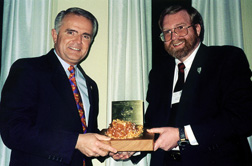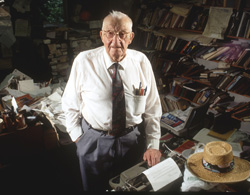geotimesheader
The
Society Page
News about
people and
announcements
from
AGI's 35
member societies
______________________ |
To
post news in the Society Page, send e-mail to geotimes@agiweb.org
with the subject: Society Page. |
Contents:
Congressional visits
Close to 300 scientists and engineers converged on Capitol Hill April
4-5 to visit their Senators and Representatives. The annual Science-Engineering-Technology
Congressional Visits Day drew a record number of attendees, including geoscientists
from 10 American Geological Institute member societies. The scientists
sent a resounding message to Congress to balance federal investment in
the physical sciences with the federal government’s strong investment in
biomedical research. They also lobbied for improved science and technology
partnerships between government, universities and industry.
Participants also delivered messages on behalf of their societies. Marguerite
Toscano, president of the Association for Women Geoscientists, supported
advancing women in the geosciences. “Thirty to 40 percent of women Ph.D.s
don’t find employment in the professional workplace,” Toscano said. “Instead
they find a chilly climate.” Other societies represented at the conference
included: the Association of American State Geologists, Clay Minerals Society,
Society for Mining, Metallurgy and Exploration, American Institute of Professional
Geologists, American Geophysical Union, Geological Society of America,
Association of Earth Science Editors, American Association of Petroleum
Geologists and Society for Sedimentary Geology (SEPM).
NAE elects geoscientists
On Feb. 17, the National Academy of Engineering elected new members,
including Franklin M. Orr, a past trustee of the AGI Foundation.
Orr is dean of the School of Earth Sciences at Stanford University and
was honored for his contributions to understanding complex multicomponent
flows in porous media and its applications to the design of enhanced oil
recovery processes.
Oceanographer Norden E. Huang of NASA’s Goddard Space Flight
Center hydrospace processes laboratory in Greenbelt, Md., was honored for
his contributions to the analysis of nonlinear stochastic signals and related
mathematical applications in engineering, biology and other sciences.
Henry H. Rachford Jr., principal technical adviser of Stoner
Associates Inc. in Houston, was honored for his contributions in the numerical
solution of partial differential equations to solve petroleum reservoir
and pipeline hydraulics problems.
Robert M. Sneider of Robert M. Sneider Exploration Inc. in Houston,
was honored for teaching and demonstrating the importance of synergistic
geological, geophysical and engineering efforts in the exploration and
development of hydrocarbon accumulations.
Garret P. Westerhoff, chairman and chief executive officer of
Malcolm Pirnie Inc. inWhite Plains, N.Y., was honored for leadership in
applying new technologies for drinking water treatment and for contributing
to international utility management.
Luis Esteva of the Institute of Engineering at the National University
of Mexico in Mexico City was honored as a new foreign associate at NAE
for his contributions to seismic design and reliability analysis of structures
and for leadership in international earthquake engineering activities.
Pick and Gavel Awards
The Association of American State Geologists presented the 2000
Pick and Gavel Awards to Rep. Jim Gibbons (R -Nev.) and Rita R. Colwell,
director of the National Science Foundation. The awards recognize individuals
who have made significant contributions to advancing the role of geoscience
in public policy and have supported AASG’s mission in government affairs.

Rep. Jim Gibbons
(R-Nev.) receives the Pick
and Gavel Award
from Jonathan price (right),
director of
the Nevada Bureau of Mines and
Geology, on
March 14. AASG. |
Gibbons was honored for his understanding and support of the applications
of geology to society. He was a co-sponsor of legislation to reauthorize
the National Cooperative Geologic Mapping Program and establish a charter
for AASG. Gibbons fought as a combat pilot in Vietnam and the Gulf War.
He has worked as a lawyer, a state assemblyman, a commercial airline pilot
and most recently as a congressman.
But first he was a geologist. He worked as a hydrologist for the Federal
Water Master, which regulates the Truckee River and Carson River that flow
from the Sierra Nevada in California into the Nevada desert. Gibbons was
also a mining and exploration geologist. His experience in industry led
to a desire to pursue the legal and environmental aspects of science policy. |
Colwell was honored for her support of earth science and education.
She has authored or co-authored 16 books and more than 500 scientific publications.
She was president of the Biotechnology Institute and professor of microbiology
at the University of Maryland before taking charge of NSF in August 1998.
The awards feature a cluster of crystals of orpiment, an arsenic sulfide
that commonly occurs in the geothermal and hydrothermal terrains of the
West. “Much research still needs to be done to fully understand arsenic’s
geological occurrences, mobilization mechanisms, hydrogeochemical movement,
biogeochemical cycles and effects on human health,” said James Robertson,
AASG president. “We hope that this mineral sample will be a reminder of
the importance of interdisciplinary and multidisciplinary research, which
Dr. Colwell has emphasized and supported during her tenure at NSF.”
Happy 100th birthday!
Even at 100 years old, Walter D. Keller of the University of Missouri
(MU) in Columbia, Mo., still drives his 1970s baby-blue Volkswagen beetle
and commonly asks graduate students and faculty intriguing questions on
current scientific literature. “If there hadn’t been mandatory retirement,
he still wouldn’t be retired,” says Glen Himmelberg, chair of the geology
department at MU.
| Keller was born March 13, 1900, in North Kansas City, Mo., and can
still remember life without electric refrigerators, telephones or televisions
and the introduction of the Model-T, the Great Depression, both world wars,
the Apollo moon landing and the Y2K bug scare. He has several favorite
field sites including the Wind River Range in Wyoming and the Refractory
Clay area in Missouri. Former graduate students recall Keller driving into
the department’s field camp in the late 1950s with his old Chevy hanging
suspiciously low to the ground. It was so full of rocks, Keller had to
jack up the bumpers each night to relieve the springs.
Keller began teaching geology at MU in 1926 after first attending as
an undergraduate. He also holds a bachelor’s degree in ceramic engineering
from the Missouri School of Mines and a master’s degree in geology from
Harvard University. He is a distinguished member of the Clay Minerals Society
and winner of many prestigious awards in geology and teaching, including
the Outstanding Educator of America Award. |

Walter
D. Keller is a living legend.
The
University of Missouri. |
The University of Missouri celebrated Keller’s birthday in gala style
on April 8, presenting the Geology Department the new $100,000 Walter Keller
Opportunities for Excellence Endowment.
Obituary
- Eduard Henri “Henk” Dahlberg
Eduard Henri “Henk” Dahlberg — a well-loved local celebrity for his
discovery of the mineral Hibbingite in his adopted hometown of Hibbing,
Minn. — died of cancer Feb. 7. He was 59.
Originally from Suriname, South America, Dahlberg earned his doctorate
in petrology from the Rijks Universiteit Utrecht the Netherlands in 1969.
He returned to Suriname to work as a geologist for the Geological Survey
and later became its director. He also worked for the Department of the
Interior in Suriname.
In 1983, Dahlberg received a Hubert Humphrey Fellowship from the University
of Minnesota and moved to the United States with his wife and son.
In 1991, while working on logging and analysis projects for the Minnesota
Department of Natural Resources, Dahlberg, manager of the Mineral Potential
Unit, discovered a new mineral barely visible to the naked eye. In 1993,
the International Mineralogical Association recognized the iron-hydroxy
chloride mineral as Hibbingite.
Dahlberg often led field trips to the Mesabi Iron Range and participated
in many organizations that focus on mineral resources. As vice president
of Small Scale Mining International, he consulted on mining and environmental
issues for developing countries, lectured for the United Nations and helped
to strengthen World Bank initiatives concerning small-scale mining. |
Associate Editor Christina Reed compiles the Society
Page.


